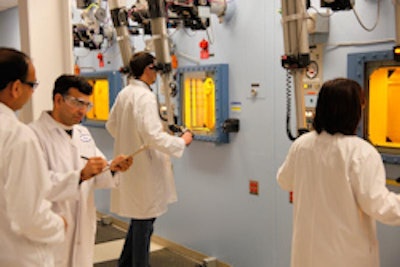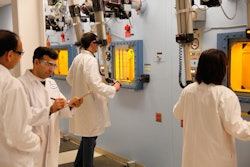
Supply shortages of molybdenum-99 could become commonplace over the next decade unless longer-term actions are taken. That is the main conclusion of a report from the Nuclear Energy Agency (NEA) of the Organization for Economic Cooperation and Development.
Published by the NEA's High-level Group on the Security of Supply of Medical Radioisotopes (HLG-MR), the report points out that more than 90% of the world's molybdenum-99 is produced by just five research reactors. These facilities are all 43 to 50 years old and two -- the National Research Universal (NRU) reactor in Canada and Osiris in France -- are expected to stop production by 2016.
Molybdenum-99 is used to produce technetium-99m, which is used in 30 million medical imaging procedures every year. Technetium-99m is bound into radiopharmaceuticals, which are injected into the body and target specific tissues or biological processes. Technetium-99m decays producing just a gamma ray, which can easily leave the body and be detected. The isotope is well suited for this application because it does not emit harmful charged particles and has a relatively long half-life (6 hours) for a gamma emitter.
The HLG-MR was set up in April 2009 in the wake of short-term isotope shortages caused by scheduled and unscheduled shutdowns of several reactors worldwide. The most significant disruption occurred in 2009-2010 when a leak put the NRU reactor in Canada out of commission for more than 13 months.
Constraints on processing capacity
Currently, all of the world's nine major isotope-producing reactors are running -- one each in Canada, South Africa, Australia, and Argentina and five in Europe. However, the HLG-MR report cautions that shortages could be expected as demand continues to grow, some reactors are shut down, and constraints remain on regional processing capacity.
 |
| A medical isotope production team at Nordion's molybdenum-99 processing facility near Ottawa. Image courtesy of Nordion. |
There are currently six major processing centers worldwide -- all near major reactors. The report points out that the processing capacity in some regions is not enough to support increased target irradiation in those locales. Indeed, during a recent global isotope shortage, reactors in Europe could not crank out targets at full capacity due to a lack of processing facilities. As a result, the HLG-MR recommends that production and processing capacities should be coordinated on a regional level.
Investment in processing needed
A new large processing facility would cost about $200 million to build. According to the report, this is a "significant investment to be made for an industry where there is uncertainty around reliability of irradiation services and a revenue stream that does not currently support the economic sustainability of the industry."
Another challenge facing processors is the ongoing shift from using highly enriched uranium (HEU) targets -- which could be used to make weapons -- to low-enriched uranium (LEU) targets. LEU targets produce less molybdenum-99 produced by HEU targets and therefore require greater processing capacity as well as the ability to dispose of more nuclear waste.
Medical isotope suppliers believe that demand for technetium-99m will grow by about 1% to 2% per year. Ignoring any problems with processing, demand is expected to outstrip supply from existing reactors by about 2017.
Impending crunch
As a result of this impending crunch, there are currently about a dozen new facilities on the drawing board, most of which are expected to come online by 2015. If all proposed facilities are built, no supply problems are expected assuming 2% growth in demand. However, when problems of processing capacity and the possibility that some projects will not proceed are factored in, the world could again face shortages by about 2021.
According to Ronald Cameron, head of the NEA's Nuclear Development Division, many of the industry's woes are related to the fact that the current economic model of production is not sustainable. Molybdenum-99 production began as a sideline for research reactors and as a result many facilities were locked into long-term supply contracts at low prices, he says.
In some cases, according to Cameron, the price of the isotopes does not cover the operating cost of the reactor. Indeed, the HLG-MR report says "current economic return on producing molybdenum-99 at the reactor is not sufficient to support the development of new infrastructure for the production of molybdenum-99; a new multipurpose research reactor has been estimated to cost more than 400 million euros." However, Cameron stresses that new facilities could be cost-effective if they pursued different business models.
Not all production methods currently under development require new reactors. TRIUMF in Canada, for example, is working on an accelerator-based method for producing the material. Another option is to use some of the world's many power reactors to make isotopes -- however, Cameron points out that this could prove difficult because it would require changes in how power reactors are regulated.
By Hamish Johnston
Physicsworld editor
December 31, 2010
Related Reading
European reactor operators form an alliance, September 21, 2010
With reactors back online, Mo-99 supply concerns remain, September 17, 2010
SNM: Long-term Mo-99 problems remain, July 8, 2010
SNM: 1 year later, Mo-99 shortage, June 8, 2010
Czechs, Belgians partner on isotopes, May 20, 2010
© IOP Publishing Limited. Republished with permission from physicsworld.com.
















